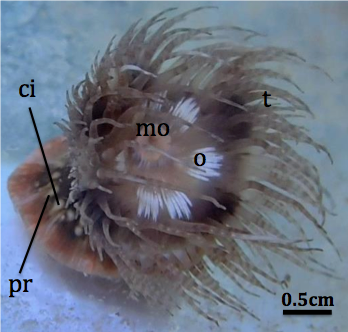Summary
Physical Description
Ecology
Life History & Behaviour
Reproduction
Feeding
Gas Exchange & Excretion
Locomotion
Anatomy & Physiology
External Morphology
Internal Anatomy & Physiology
Acontia
Retraction-Deflation Sequence
Autofluorescence
Evolution & Systematics
Evolution with Hermit Crabs
Phylogenetics
Biogeographic Distribution
Global Distribution
Local Distribution
Conservation & Threats
References & Links | External Morphology
Sea anemones are diploblastic animals, meaning they have two germ layers; the endoderm and the ectoderm. The endoderm gives rise to the gastrodermis and the ectoderm gives rise to the epidermis. C. polypus is in polyp form, which consists of a tubular column with an oral disc, and lacks a medusa stage, meaning it is largely sessile. It is radially symmetrical and the column is cylindrical rising from the pedal disc. C. polypus is polarized along an oral-aboral axis that parallels the environmental gradient (gravity). At the oral end of the animal, the manubrium is situated in the centre of the oral disc, enclosing the entrance to the mouth. The margin of the oral disc bears a whorl of tentacles. The mouth leads to a laterally compressed tubular pharynx that opens into the coelenteron. As the pharynx and mouth are laterally compressed, they appear to be elongated slits. The opposite ends of the slits are ciliated grooves called siphonoglyphs. Cinclides appear on the body wall on white protuberances, through which coelenteric fluid and acontia are released. (Ruppert E.E., 2004)
|

|
Figure 1: C. polypus specimen. pr = protuberances; ci = cinclides; mo = mouth; o = oral disc;
t = tentacles |
|
|